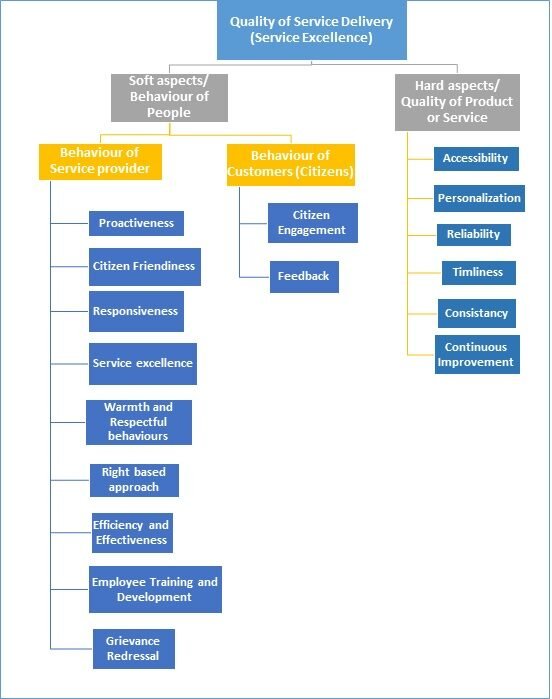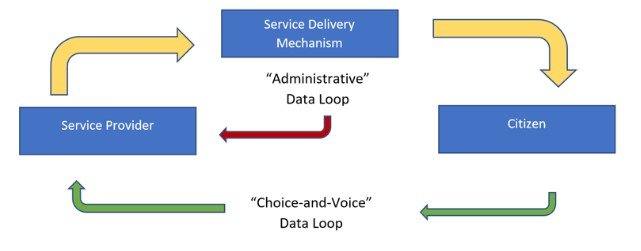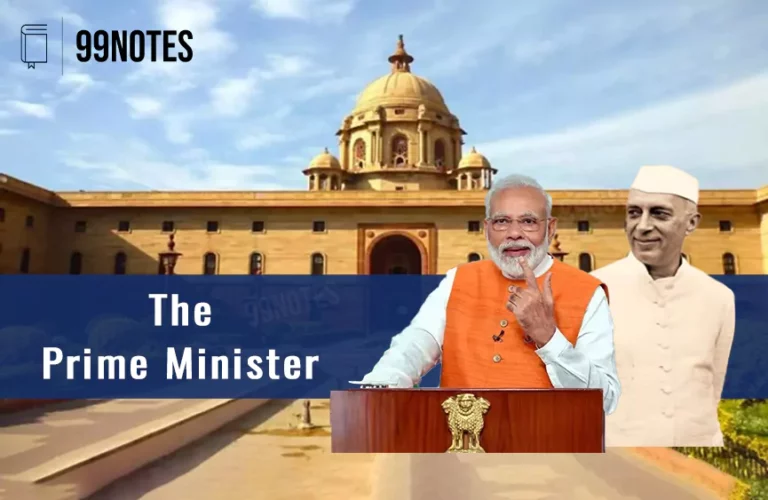Quality of Service Delivery
Quality service delivery is when the right type of services are provided to the right people, at the right time, and in the right manner. The quality of service delivery refers to the level of excellence, and effectiveness in the services that are provided to customers or clients.
Public service delivery refers to the delivery of Public Goods and Services by government agencies to citizens. Public services are delivered to the public by local, municipal, state, or federal governments. Public healthcare, education, insurance, public safety, Public Infrastructure, sewage and trash disposal, and street cleaning, are some of the examples of public services.
The aim of public service delivery is to meet the needs and expectations of citizens in an efficient and effective manner while ensuring transparency and accountability. Actual performance and expectations are compared to determine the quality of service delivery.
Key Elements of Quality of Service Delivery
- Key Elements of Quality of Service Delivery
- Proactiveness
- Citizen Friendly
- Responsiveness
- Service Excellence
- Warmth and Respectful behaviour
- Rights-based Approach
- Efficiency and Effectiveness
- Employee Training and Development
- Grievance Redressal
- Public Engagement
- Feedback and Evaluation
- Accessibility
- Personalization
- Reliability
- Timeliness
- Continuous Improvement
- Challenges to Quality of Public Service Delivery
- Ways to improve Quality of Public service delivery
- Conclusion
The Following are key aspects that are considered while determining the quality of service delivery:
Proactiveness
Proactive public services are when eligible beneficiaries get public service delivery with the least effort and the government takes proactive measures to ensure that eligible beneficiary is not excluded. For example, the Delhi government started a Doorstep service delivery scheme under which it is currently providing more than 100 public services mainly documents such as driving licenses and domicile certificates at the doorstep.
Citizen Friendly
Quality service delivery starts with a citizen-centric approach i.e. focusing on understanding and meeting the needs and expectations of citizens. For example, to make Public Service delivery systems ‘citizen-friendly’ the Karnataka government started the ‘Sakala mission’.
Responsiveness
Adopting innovation and adapting to changing customer needs is essential for maintaining quality service delivery. Responsiveness refers to the extent to which a public service agency demonstrates receptivity to the new ideas, complaints, and suggestions of citizens, by implementing changes such as changing organization structure, culture, and service delivery patterns.
This helps to cater to citizens’ needs effectively with a more appropriate product. For example, moving away from its earlier approach, now the government has launched the Viksit Bharat Sankalp Yatra across India. It aims to take welfare measures to beneficiaries’ doorsteps through intensive outreach activities and achieve saturation of various welfare schemes launched by the Government of India.
Service Excellence
Service excellence involves striving to consistently exceed customer expectations and delivering services of exceptionally high quality. The Sevottam model is recommended by the 2nd ARC as a model to achieve ‘Service Excellence’ in public service delivery. Its three components are Citizens’ Charters, Public Grievance System, and Excellence in Service Delivery.
Warmth and Respectful behaviour
An important element of the quality of public service is the way citizens are treated by public officials. Warmth and respect are considered essential skills for the relationship-building aspect of public service delivery. These are even more crucial in challenging and/or distressing situations.
For example, healthcare providers such as ASHA, and ANM must have an empathetic attitude to increase penetration of institutional deliveries, vaccination, and healthy childcare practices. However, these skills are often treated as common sense, and generally, no formal training is provided.
Rights-based Approach
A rights-based approach focuses on developing the capacity of duty-bearers to meet their obligations of public service delivery and encouraging rights holders to claim the benefits as a matter of rights. The human rights-based approach focuses on meeting the basic needs of those who are most marginalized, excluded, or discriminated against. This often requires an analysis of prevailing gender norms, different forms of discrimination, and power imbalances to ensure that interventions reach the most marginalized sections of the population.
Efficiency and Effectiveness
Quality service delivery depends not only on the efficiency of resource utilization but also on effectiveness in achieving desired outcomes. For instance, the efficiency of the Karamyogi Mission can be determined by number of training sessions conducted or number of officials who received training. Whereas, its effectiveness can be judged by improvement in the productivity of public officials and in the quality of public service delivery.
Employee Training and Development
Providing public officials with ongoing training and development opportunities ensures that they have required skills and knowledge to deliver quality public services. For this purpose government launched, the Framework of Roles, Activities, and Competencies (FRAC). This is a part of Mission Karmayogi’s Integrated Government Online Training Platform (iGOT) initiative, which maps three constructs (roles, activities, and competencies) supported by knowledge resources for each individual position within all government departments.
Grievance Redressal
Grievance refers to “a feeling of resentment over something felt to be wrong or unfair by citizens”. Grievance redressal includes “actions taken on any issue” raised by citizens, mainly to avail services more effectively.
A grievance includes complaints raised by citizens for wrongful action by any public official/agency that needs proper redressal. A grievance may include complaints on service unavailability, not meeting expected performance levels; excessive delays; discrimination; staff misbehavior; corruption; malpractices; favoritism or nepotism; maladministration, etc.
The Centralised Public Grievance Redress and Monitoring System (CPGRAMS) is set up by the government as a platform for entertaining grievances of the public round the clock (24×7).
Public Engagement
Effective communication and transparency in service delivery processes help increase public engagement which is crucial in ensuring quality of service delivery. The central government launched the People’s Plan Campaign for panchayats with the slogan ‘Sabki Yojana Sabka Vikas’. It will ensure the preparation of participatory Gram Panchayat Development Plans in which people themselves choose development projects and plans.
Feedback and Evaluation
Seeking citizen feedback and conducting regular evaluations help identify shortcomings and areas of improvement. Feedback and Evaluation are also indispensable parts of citizen charters as well as the Sevottam model. Further, several measures are taken by the government such as mygov.in, UMANG app and portals of government ministries/departments, which provide mechanisms for online feedback by citizens.
As shown in the figure the feedback loop can collect feedback at different points in the delivery chain. The administrative data loop collects feedback from different stakeholders in the delivery chain, while the choice and voice loop collects data on the service experience of the citizens. Feedback is used to measure service levels, and user satisfaction, and diagnose problems.
Measurement and evaluation of actual performance with regard to expected performance standards help in determining the quality of service delivery. The government has implemented a 360-degree appraisal system involving Multi-Source Feedback from various stakeholders. The process also takes into account the overall service record and vigilance status.
On the other hand, Social audits or Jansunwai are mechanisms of evaluation of performance by citizens directly.
Accessibility
The aim of public welfare schemes can be achieved only when they are conveniently accessible to the target population. Accessibility includes not only physical accessibility but also accessibility by way of improved awareness of citizens. The term is often used in the context of persons with disabilities. The government has started the Accessible India campaign (Sugamya Bharat Abhiyan) with the aim of providing PWDs easy access to public buildings.
There are several general measures taken by the government such as e-governance measures, online portals, awareness campaigns, etc. to improve the accessibility of public services for the general public.
Personalization
Public services should cater to the actual needs, expectations, and preferences of target beneficiaries. When public goods/services are designed as per the actual needs of citizens they enhance the overall customer experience. For instance, PM Fasal Bima Yojana has low rates of premium so that even small and marginal farmers can afford it.
Services that are not tailored to the needs of citizens lead to not only poor quality of service delivery but also a wastage of public resources. Under PM Awas Yojana as of December 2022, 5.6 lakh houses were not delivered to beneficiaries due to a lack of basic amenities (as per report of Standing Committee on Housing and Urban Affairs).
Reliability
Quality service delivery entails that the services delivered are error-free, minimizing mistakes and creating reliable outcomes. Reliability refers to consistently maintaining high quality in services delivered over a period of time. Citizens can be sure that they will receive high-quality service at every encounter. However, a reduction in the quality of services is seen in several government schemes which leads to the failure of even well-designed schemes.
Reliability is one of the most dominant factors in determining customer/citizen satisfaction. For instance, public utility services like electricity can be considered reliable when a 24*7 electricity supply is provided to citizens in a hassle-free manner, meeting citizen needs while maintaining citizen satisfaction over a period of time.
Timeliness
“A right delayed is a right denied” maxim entails that public services that are not delivered on time are not effective in meeting citizen needs/amount to a denial of basic citizen rights. Delivering services within the specified timeframes or deadlines is crucial for meeting customer needs and maintaining customer satisfaction. For instance, the Ayushman Bharat scheme is relevant only when health care is provided in a timely manner. Delayed service delivery can lead to loss of health or life to the beneficiary.
Continuous Improvement
A continuous cycle of monitoring, evaluating, and improving service delivery performance is an essential part of high-quality service delivery. With time needs of citizens may change. Also, there can be changes in technology or resource availability. All this requires continuous fine-tuning of the services offered. For example, Ration cards are now seeded with Aadhar and enabled with technology that has made “one nation one ration card” a reality.
Challenges to Quality of Public Service Delivery
There is a general view that public services are for the poor and of low quality. This is true to some extent because the quality of Public Service delivery in India is marred by a number of challenges.
Limited resources of the government
The government has limited resources at its disposal, however, there are a number of competing demands on these limited resources. This is why government often has to balance the demands of providing a wide range of services with limited resources.
This can make it difficult to deliver services at the level of quality that citizens expect or meet the benchmark. For example, the number of government hospitals is not sufficient which creates excessive burden on hospital facilities and medical staff. This adversely affects the quality of health care provided at government hospitals.
Systemic challenges
The public service delivery system in India is plagued by entrenched Issues such as corruption, leakages, Red tape, lack of innovation, complex policies, long hierarchy, outdated regulations, and so on. These can create delays and inefficiencies in the service delivery process. For instance, due to leakages in the Public Distribution System (PDS) by way of the diversion of subsidized grains to the black market, the poor are deprived of food security.
Lack of coordination between agencies
A number of government agencies and departments need to coordinate to effectively deliver public services. These may have a lack of communication or conflicting views or priorities, which can affect the quality of services delivered.
Technological challenges
The government has introduced innovative technologies to improve the efficiency and effectiveness of service delivery. However, adoption as well as maintenance of new technological solutions present challenges such as inertia in staff leading to resistance, high costs, lack of trained staff, etc.
Populism
Prevalence of ‘identity politics’, in which citizens prefer to vote for politicians belonging to a particular community, caste, and/or religion. Political considerations and vote bank politics can sometimes influence the decision-making of governments, which can impact the quality of service delivery.
Limited Access to services
In India, many regions lack basic infrastructure which makes service delivery difficult. Lack of proper roads may hamper access to health care as well as education. Similarly, lack of internet connectivity may lead to deprivation of delivery of education, skilling, or livelihood opportunities.
Lack of Motivation
The lack of motivation among government officials to complete their work on time as they do not have to face any penalty or punishment for the delay. Similarly, there is a lack of incentive to be efficient. For example, Government teachers rarely show a high level of motivation because there is no reward for good performance or penalty for poor performance.
Lack of private sector participation
There is almost a government monopoly over the provision of various public services in India, such as in healthcare, education, public transport, and utility services such as electricity and water supply. This monopoly reduces competition, professionalism and creates complacency in government agencies. All these in turn impact the quality of service delivery.
Ways to improve Quality of Public service delivery
Well-designed public services and goods
Well Informed policy-making, and designing of public services schemes only after proper research and public feedback is crucial. This reduces the gap between public services delivered and actual public needs.
System of reward and punishment
The pay of public servants should be linked to their performance and the quality of services delivered by them. Performance-based incentives may encourage public servants to stay motivated to maintain and improve the quality of services.
Private Sector participation
Private sector participation increases competition and pushes towards improvement of quality. Similarly, private sector participation promotes efficient use of resources, cost-cutting, deployment of better technology, and better citizen orientation. For example, some DISCOMS are in the private sector. Their participation promotes the reduction of losses and efficient electricity supply.
Active participation of the citizenry
Tools such as Citizen Report Cards based on citizen responses to the quality of service can help in improving the quality of services.
Rights-based approach
A rights-based approach empowers citizens and creates an obligation on the government to meet certain basic needs of citizens. For example, the Right to Education Act, of 2009 helps delivery of high-quality primary education as a matter of right.
Many states, such as Punjab, have passed the Right to Public Service Acts to mandate the timely delivery of services to people.
Curbing Corruption and leakages
Corruption badly affects the quality of services delivered. For instance, a corrupt official can ask for a bribe to deliver routine services such as registering birth/death. Curbing corruption helps eliminate leakages and waste of public resources. Also, more resources can be made available to meet the needs of citizens.
Technology-enabled service delivery
The use of technology not only enables easy access but also helps in improving the quality of public goods/services delivered. For example, the use of Direct Benefit transfer for payment of MGNREGS wages directly into the beneficiary’s account has helped eliminate exclusion and inclusion errors. It also ensures timely and hassle-free payment of wages.
Conclusion
“Public service must be more than doing a job efficiently and honestly. It must be a complete dedication to the people and to the nation” – Margaret Chase Smith
Quality public service delivery is a foundational aspect of building a welfare state and achieving the socio-economic development of the nation. By properly accurately assessing citizens’ needs before designing public services, ensuring effective utilization of available public resources, developing basic infrastructure, embracing a culture of continuous improvement, and ensuring efficient and effective processes, governments can enhance the quality of service delivery. Quality service delivery not only meets citizen expectations but also contributes to citizen loyalty and participation which is crucial for the growth of the nation.
| Previous Year Questions |
|






